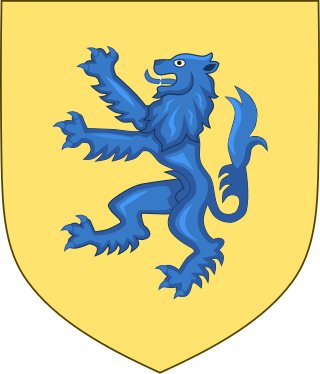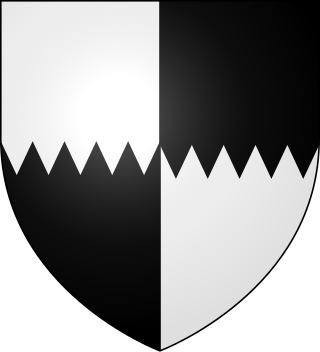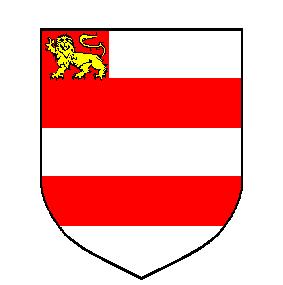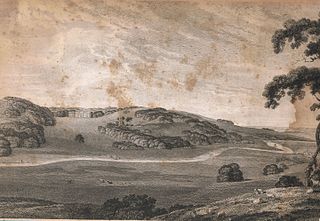
Sir Marmaduke Thweng (or Tweng, Thwinge etc.), later 1st Baron Thweng, was an English knight from Yorkshire who fought in the Wars of Scottish Independence. [3]

Sir Marmaduke Thweng (or Tweng, Thwinge etc.), later 1st Baron Thweng, was an English knight from Yorkshire who fought in the Wars of Scottish Independence. [3]
The son of Sir Marmaduke Thweng of Kilton and his wife Lucy de Brus. His mother was the great, great-granddaughter of Adam de Brus, Lord of Skelton brother to Robert de Brus, 1st Lord of Annandale, Thweng was also a vassal of Robert de Brus, 6th Lord of Annandale by virtue of the latter's fief in the North Riding, ties that would have far reaching effects during his career.
In 1295 he fought for King Edward I in Gascony, along with John de Thweng. [4]
In 1297 Marmaduke achieved some fame at the Battle of Stirling Bridge by an heroic escape. Over 100 English knights had been trapped, together with several thousand infantry, on the far side of the river, and were being slaughtered by the Scots. Thweng managed to fight his way back across the bridge and he thus became the only knight of all those on the far side of the river to survive the battle. Following the rout, Thweng with William FitzWarin were appointed castellans of Stirling Castle by the English leader John de Warenne, 6th Earl of Surrey. The castle was quickly starved into submission, and Thweng and FitzWarin were taken prisoner to Dumbarton Castle. He was summoned to Parliament in 1307, thus becoming Baron Thweng. [5]
At the Battle of Bannockburn in 1314, however, after the English defeat, Sir Marmaduke apparently made no attempt to escape. Instead he wandered over the battlefield until he located Robert the Bruce; only then was he prepared to surrender, and only to the victorious King. Robert recognised Sir Marmaduke and released him and Ralph de Monthermer, also captured, both without ransom, but not without first entertaining them at table. [6]
Thweng married Isabel de Ros, daughter of William de Ros of Ingmanthorpe, and had several children, including:
His three sons each succeeded to the barony in turn; the first son married, but died childless, while the second and third sons were clergymen and died unmarried. With the death of the last son, the barony fell into abeyance among the heirs of his daughters. [7]

Baron Willoughby de Eresby is a title in the Peerage of England. It was created in 1313 for Robert de Willoughby. Since 1983, the title has been held by Jane Heathcote-Drummond-Willoughby, 28th Baroness Willoughby de Eresby.
John FitzAlan III, was an English nobleman. He was also Lord and Baron of Clun and Oswestry in the Welsh Marches.
Robert de Brus, 6th Lord of Annandale, jure uxoris Earl of Carrick (1252–1292), Lord of Hartness, Writtle and Hatfield Broad Oak, was a cross-border lord, and participant of the Second Barons' War, Ninth Crusade, Welsh Wars, and First War of Scottish Independence, as well as father to the future king of Scotland Robert the Bruce.

Robert V de Brus, 5th Lord of Annandale, was a feudal lord, justice and constable of Scotland and England, a regent of Scotland, and a competitor for the Scottish throne in 1290/92 in the Great Cause. He is commonly known as "Robert the Competitor". His grandson Robert the Bruce eventually became King of Scots.

William de Redvers, 5th Earl of Devon, of Tiverton Castle and Plympton Castle, both in Devon, was feudal baron of Plympton in Devon.

Clan Bruce is a Lowlands Scottish clan. It was a royal house in the 14th century, producing two kings of Scotland, and a disputed High King of Ireland, Edward Bruce.

Robert I de Brus, 1st Lord of Annandale was an early-12th-century Anglo-Norman lord and the first of the Bruce dynasty to hold lands in Scotland. A monastic patron, he is remembered as the founder of Gisborough Priory in Yorkshire, England, in present-day Redcar and Cleveland, in 1119.

John Bourchier, 1st Baron Berners, KG was an English peer.

John Bourchier, 2nd Earl of Bath, was an Earl in the peerage of England. He also succeeded to the titles of 12th Baron FitzWarin, Baron Daubeney and 4th Count of Eu.

Baron FitzWarin was a title in the Peerage of England created by writ of summons for Fulk V FitzWarin in 1295. His family had been magnates for nearly a century, at least since 1205 when his grandfather Fulk III FitzWarin obtained Whittington Castle near Oswestry, which was their main residence and the seat of a marcher lordship.

James Audley, 2nd Baron Audley of Heighley Castle, Staffordshire, was an English peer. He was the son and heir of Nicholas Audley, 1st Baron Audley (1289–1316) by his wife Joan Martin, who was the daughter of William Martin, feudal baron of Barnstaple, and Marcher Lord of Kemes. She was posthumously the eventual sole heiress of her brother William FitzMartin to Barnstaple and Kemes.

Hugh de Courtenay, 1st/9th Earl of Devon of Tiverton Castle, Okehampton Castle, Plympton Castle and Colcombe Castle, all in Devon, feudal baron of Okehampton and feudal baron of Plympton, was an English nobleman. In 1335, forty-one years after the death of his second cousin once-removed Isabel de Redvers, suo jure 8th Countess of Devon he was officially declared Earl of Devon, although whether as a new creation or in succession to her is unknown, thus alternative ordinal numbers exist for this Courtenay earldom.

Henry Percy, 9th Baron Percy of Topcliffe, 2nd Baron Percy of Alnwick was the son of Henry de Percy, 1st Baron Percy of Alnwick, and Eleanor Fitzalan, daughter of Sir Richard FitzAlan, 8th Earl of Arundel, and sister of Edmund FitzAlan, 9th Earl of Arundel.

Sir William FitzWarin was an English soldier active during the First War of Scottish Independence. He was the constable of Urquhart Castle (1296-1297) and after the English defeat at the Battle of Stirling Bridge on 11 September 1297, he was appointed constable of Stirling Castle, which he later surrendered and was imprisoned in Dumbarton Castle.

From AD 1066, the feudal barony of Barnstaple was a large feudal barony with its caput at the town of Barnstaple in north Devon, England. It was one of eight feudal baronies in Devonshire which existed in the Middle Ages. In 1236 it comprised 56 knight's fees or individual member manors. The feudal service owed for half the barony in 1274 was the provision to the royal army of two knights or four sergeants for forty days per annum, later commuted to scutage.

Gilbert fitz Roger fitz Reinfried, or Gilbert the son of Roger fitzReinfrid, was an Anglo-Norman feudal baron whose administrative career in England began in the time of Henry II (1154-1189), for whom his father Roger fitzReinfrid had been steward, and continued during the reigns of Richard I, King John, and Henry III.

The feudal barony of Bampton was one of eight feudal baronies in Devonshire which existed during the mediaeval era, and had its caput at Bampton Castle within the manor of Bampton.

The historic manor of Tawstock was situated in North Devon, in the hundred of Fremington, 2 miles south of Barnstaple, England. According to Pole the feudal baron of Barnstaple Henry de Tracy made Tawstock his seat, apparently having abandoned Barnstaple Castle as the chief residence of the barony. Many of the historic lords of the manor are commemorated by monuments in St Peter's Church, the parish church of Tawstock which in the opinion of Pevsner contains "the best collection in the county apart from those in the cathedral", and in the opinion of Hoskins "contains the finest collection of monuments in Devon and one of the most notable in England".

Kilton Castle is a ruined castle overlooking the valley of Kilton Beck, near to the village of Kilton in the historic county of the North Riding of Yorkshire in England. The castle was built in the 12th century and was described as being in a ruinous state by the 14th century, with it being totally abandoned by the 16th century. Kilton Castle was owned by several noble families who hailed from the area; de Brus, de Kilton, Autrey, de Thweng, de Lumley.

Sir John FitzMarmaduke, Lord of Horden, Eighton, Lamesley, Ravensholm, and Silksworth, Sheriff of North Durham, and Joint Warden beyond the Scottish Sea between the Firth of Forth and Orkney, was an English knight from Durham who fought in the Wars of Scottish Independence.